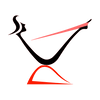Has anyone said to you that there is no such thing as lower abdominals?
I would counter that argument and say YES there are lower abs! Muscles often have slightly different functions based on the direction of their muscle fibers. Take for instance the Gluteus Medius and the prevalence of weakness in the posterior Gluteus Medius because of hip flexor and Tensor Fasciae latae over activity.
The abdominal region is very large, spanning from pubic bone and pelvis up to the ribs and diaphragm. Thus, it is important to take a look at how the muscle fibers even within the same abdominal muscle start to take on a different line of pull and thus a different action or "job".
Women especially have weakness in the region of their abdominal wall from navel to pubic bone (lower abdominal region). This is due to a whole slew of issues: painful periods, IBS, pregnancies and especially C-Sections etc. Often the posture seen is a clenched upper abdominal region with distended lower abdominal region. The female is clenching where she is strong and released where she has decreased awareness and/or ability to contract. This is often called the Mommy's Pooch. Please see picture below.

For sure, there may be fat deposits and bloat that contributes to this issue but the weakness in this lower abdominal region is what can be changed with exercise.
The transversus abdominis (TA) and the lower internal obliques (LIO) have fibers that run parallel and also on a slightly upward direction from pubic bone. Thus when those portions of the TA and LIO contract they will cinch together and slightly pull the pubic bone upward...the muscular contraction needs to fall inline with muscle fibers orientation. See pictures below taken from the book, Atlas of Human Anatomy by Netter


Now I would like for you to feel these lower abdominal activate. We will use the movement of the legs toward midline to help activate these muscles. You will need to lie on your back back and position your low back and pelvis in neutral. If you do not know what neutral spine is please check out this short video.
You are in neutral spine with you legs bent and feet hip distance apart. Inhale, through your nose and allow the legs to open out to the sides. Exhale, start to move your legs back to start position as you narrow your lower abdominals (could feel like a wire connecting the front pelvis bones - Pretend like you are wearing a string bikini - right there!). This is a great exercise to wake those lower abdominals up.
To further improve strength in this region you need to make sure you maintain this low abdominal connection as you further increase challenge to the neutral position and abdominal connection with your legs. Often, Leg Scissors are an exercise prescribed to target the lower abdominals BUT if you are weak and just starting to get these muscle to fire...Leg Scissors are a BIG challenge - maybe too big of a challenge.
On the Pilates Reformer we use resistance of the springs and the straps to help support legs. Please check out your local Pilates studio because there are so many targeted exercises you can do on a Reformer with professional guidance so that you learn to activate your lower abdominals correctly.
However, you can also use resistance bands to hold the weight of your legs.
As a physical therapist and Pilates instructors I wanted to create home exercise programs that helped my clients recreate the Pilates Reformer exercises at home or while traveling, so I invented the patented HANDIBANDS. Which are resistance bands that are adjustable to your height. Furthermore, either end attaches inside a door jamb so you can recreate reformer exercises on a mat or hands free by attaching the HANDIBANDS inside a door jamb. Below is a video demonstrating how you can target low abdominals with resistance of the HANDIBANDS attached inside a door jamb to help hold the weight of your legs so that you exercise in good technique....You get what you train so train correctly...no abdominals pushing out.... but drawing together!

